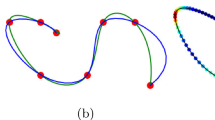Abstract
In this article we extend the computational geometric curve reconstruction approach to the curves embedded in the Riemannian manifold. We prove that the minimal spanning tree, given a sufficiently dense sample, correctly reconstructs the smooth arcs which can be used to reconstruct closed and simple curves in Riemannian manifolds. The proof is based on the behavior of the curve segment inside the tubular neighborhood of the curve. To take care of the local topological changes of the manifold, the tubular neighborhood is constructed in consideration with the injectivity radius of the underlying Riemannian manifold. We also present examples of successfully reconstructed curves and show applications of curve reconstruction to ordering motion frames.




















Similar content being viewed by others
Notes
We restrict out attention to smooth curves, i.e. curves which are C ∞.
Homeomorphic here can be replaced by diffeomorphic for a differentiable manifold.
For notations and definitions of basic differential geometric terms, we refer to [12].
References
Altafini, C.: The de Casteljau algorithm on se(3). In: Isidori, A., Lamnabhi-Lagarrigue, F., Respondek, W. (eds.) Nonlinear Control in the Year 2000. Lecture Notes in Control and Information Sciences, vol. 258, pp. 23–34. Springer, Berlin (2000). http://dx.doi.org/10.1007/BFb0110205.10.1007/BFb0110205
Althaus, E., Mehlhorn, K.: Polynomial time tsp-based curve reconstruction. In: Proc 11th ACM-SIAM Sympos Discrete Algorithms, pp. 686–695 (2000)
Althaus, E., Mehlhorn, K., Näher, S., Schirra, S.: Experiments on curve reconstruction. In: Proc. 2nd Workshop Algorithm Eng. Exper, pp. 103–114 (2000)
Amenta, N., Bern, M., Eppstein, D.: The crust and the β-skeleton: combinatorial curve reconstruction. Graph. Models Image Process. 60, 125–135 (1998)
Basser, P.J., Pajevic, S., Pierpaoli, C., Duda, J., Aldroubi, A.: In vivo fibre tractography using DT-MRI data. Magn. Reson. Med. 44, 625–632 (2000)
Bougleux, S., Peyre, G., Cohen, L.: Anisotropic geodesics for perceptual grouping and domain meshing. In: ECCV2008, vol. 5303, pp. 129–142 (2008). http://www.springerlink.com/index/t10k26241022w670.pdf
do Carmo, M.P.: Riemannian Geometry. Birkhäuser, Basel (1992)
Dey, T.K.: Curve and Surface Reconstruction: Algorithms with Mathematical Analysis. Cambridge University Press, Cambridge (2007)
Dey, T.K., Kumar, P.: A simple provable curve reconstruction algorithm. In: Proc. 10th Ann. ACM-SIAM Symp. Discrete Algorithms (1999)
Edelsbrunner, H.: Shape reconstruction with Delaunay complex. In: LNCS 1380, LATIN’98: Theoretical Informatics, pp. 119–132 (1998)
de Figueiredo, L.H., de Miranda Gomes, J.: Computational morphology of curves. Vis. Comput. 11, 105–112 (1994)
Gray, A., Abbena, E., Salamon, S.: Modern differential geometry of curves and surfaces with mathematica. In: Studies in Advanced Mathematics. Chapman & Hall, London (2006)
Kim, M.J., Kim, M.S., Shin, S.Y.: A c 2-continuous b-spline quaternion curve interpolating a given sequence of solid orientations. Computer Animation 72 (1995). http://doi.ieeecomputersociety.org/10.1109/CA.1995.393545
Kimmel, R., Sethian, J.A.: Computing geodesic paths on manifolds. In: Proc. of National Academy of Sciences, USA, vol. 95, pp. 8431–8435 (1998)
Leibon, G., Letscher, D.: Delaunay triangulations and Voronoi diagrams for Riemannian manifolds. In: Symposium on Computational Geometry, pp. 341–349 (2000)
Li, J., Hao, P.-w.: Smooth interpolation on homogeneous matrix groups for computer animation. J. Zhejiang Univ. Sci. 7, 1168–1177 (2006). http://dx.doi.org/10.1631/jzus.2006.A1168.10.1631/jzus.2006.A1168
Lucas, B.D., Kanade, T.: An iterative image registration technique with an application to stereo vision. In: Intl. Joint. Conf. on Artificial Intelligence (1981)
Mansouri, A.R., Mukherjee, D.P., Acton, S.T.: Constraining active contour evolution via Lie groups of transformation. IEEE Trans. Image Process. 13(6), 853–863 (2004). http://viva.ee.virginia.edu/publications/04_Constraining.pdf
O’Rourke, J.: Computational Geometry in C, 2nd edn. Cambridge University Press, Cambridge (1998)
Park, F.C.: Distance metrics on the rigid-body motions with applications to mechanism design. J. Mech. Des. 117(1), 48–54 (1995)
Park, F.C., Ravani, B.: Smooth invariant interpolation of rotations. ACM Trans. Graph. 16(3), 277–295 (1997)
Shoemake, K.: Animating rotation with quaternion curves. SIGGRAPH Comput. Graph. 19(3), 245–254 (1985). http://doi.acm.org/10.1145/325165.325242
Spivak, M.: A Comprehensive Introduction to Differential Geometry, vol. 1. Publish or Perish, Berkeley (1999). http://www.jstor.org/stable/2319112?origin=crossref
Wang, Y., Wang, D., Bruckstein, A.M.: On variational curve smoothing and reconstruction. J. Math. Imaging Vis. 37(3), 183–203 (2010)
Zefran, M., Kumar, V., Croke, C.: On the generation of smooth three-dimensional rigid body motions. IEEE Trans. Robot. Autom. 14(4), 576–589 (1995)
Acknowledgements
The authors would like to acknowledge Prof. Gautam Dutta for discussions on the proof of the results in this article. The authors would also like to thank the resource center DAIICT for providing references needed for the work carried out. We acknowledge INRIA, Gamma researcher’s team, http://www-roc.inria.fr/gamma/gamma/disclaimer.php, for their 3D-mesh files which we have used for simulations. We also like to thank anonymous referees for their constructive comments and suggestions.
Author information
Authors and Affiliations
Corresponding author
Appendix: Exponential and Logarithmic Maps
Appendix: Exponential and Logarithmic Maps
A1
Given [ω]∈so(3),
A2
Let (ω,v)∈se(3). Then
where
A3
Given θ∈SO(3) such that \(\operatorname{Tr}(\theta)\neq -1\). Then
where ϕ satisfies \(1+2 \cos\phi = \operatorname{Tr}(\theta)\), |ϕ|<π. Further more, ∥logθ∥2=ϕ 2.
A4
Suppose θ∈SO(3) such that \(\operatorname{Tr}(\theta)\neq -1\), and let b∈ℝ3. Then
where [ω]=logθ, and
A5
Let θ 1,θ 2∈SO(3). Then the distance L=d(θ 1,θ 2) induced by the standard bi-invariant metric on SO(3) is
where ∥⋅∥ denotes the standard Euclidean norm.
A6
Let X 1=(θ 1,b 1) and X 2=(θ 2,b 2) be two points in SE(3). Then the distance L=d(X 1,X 2) induced by the scale dependent left-invariant metric on SE(3) is
where ∥⋅∥ denotes the Euclidean norm.
Rights and permissions
About this article
Cite this article
Shah, P., Chatterji, S. On the Curve Reconstruction in Riemannian Manifolds. J Math Imaging Vis 45, 55–68 (2013). https://doi.org/10.1007/s10851-012-0344-0
Published:
Issue Date:
DOI: https://doi.org/10.1007/s10851-012-0344-0




